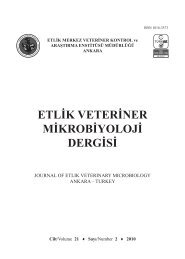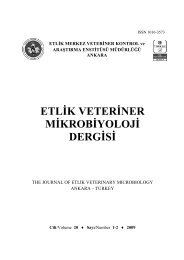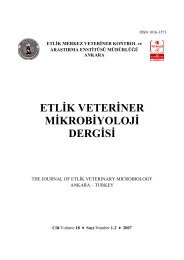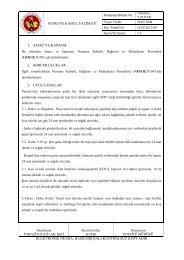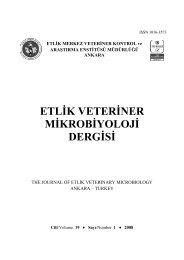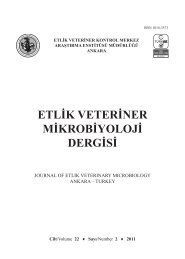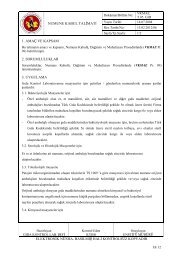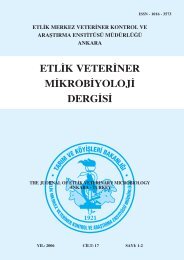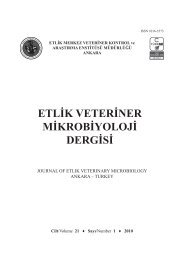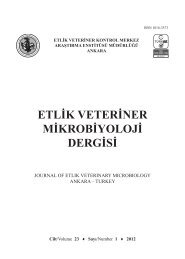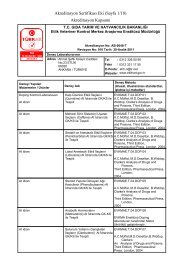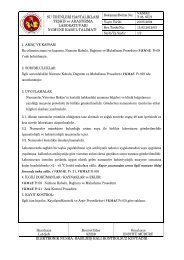Cilt/Volume 23 Sayı/Number 2 2012 - veteriner kontrol merkez ...
Cilt/Volume 23 Sayı/Number 2 2012 - veteriner kontrol merkez ...
Cilt/Volume 23 Sayı/Number 2 2012 - veteriner kontrol merkez ...
Create successful ePaper yourself
Turn your PDF publications into a flip-book with our unique Google optimized e-Paper software.
tivity caused by L.anguillarum isolated from rainbow<br />
trout in different farms located in the Middle<br />
and Mediterranean regions of Turkey.<br />
Materials and Methods<br />
Sampling: The outbreaks were occurred rainbow<br />
trout (body weight 50-300 g) in five different fresh<br />
water farms in the Middle and Mediterranean regions<br />
of Turkey. Samples came from 5 fish farms<br />
during 2004-2005. The postmortem examinations of<br />
external and internal disease signs were performed.<br />
Isolation and identification of bacteria: For<br />
bacterial isolation, samples were obtained from the<br />
kidney and liver of 10 fish, streaked on trypticasesoy<br />
agar (TSA, Merck) supplemented with 1%<br />
NaCl plates, and incubated at 25°C for 48 h. Single<br />
colonies were restreaked on the same media to obtain<br />
pure isolates. Isolated colonies were identified<br />
by physiological and biochemical characterization.<br />
Routine tests were carried out for determination of<br />
biochemical characteristics of the bacteria, as described<br />
previously (6, 7, 10).<br />
A presumptive identification of the strain was<br />
performed using the following tests: Gram staining,<br />
motility, fermentative degradation of glucose with<br />
O/F basal medium (Merck) supplemented with 1%<br />
glucose, oxidase, catalase, production of indole, citrate<br />
utilization, hydrolysis of starch and gelatine,<br />
Methyl red-Voges proskouer tests, production of<br />
H 2 S, growth at peptone water with 0, 2, 7, 8 and<br />
10% NaCl, growth in thiosulphate citrate bile salts<br />
sucrose agar (TCBS), growth at Tryptic Soy Broth<br />
at 4°C, 25°C, 37°C, inhibition by the vibriostatic<br />
agent O/129 (2,4-diamino-6,7-di isopropylpteridine;<br />
Oxoid) and fermentation of carbohydrates<br />
(glucose, arabinose, inositol, saccharose, maltose,<br />
fructose, lactose, galactose, rhamnose, mannitol,<br />
sorbitol, amygdalin, mellibiose). Additional test<br />
were performed using API 20 E (bioMérieux) (2).<br />
Metin S. Etlik Vet Mikrobiyol Derg, <strong>23</strong>, 44-48, <strong>2012</strong> 45<br />
In all the tests, L.anguillarum ATCC 14181 was<br />
used as a reference.<br />
Antimicrobial sensitivity: Antimicrobial<br />
tests were performed on the isolate at 25°C by using<br />
a disc diffusion assay on Mueller-Hinton agar<br />
(Oxoid). CLSI standards were used for the evaluation<br />
of the results (5).<br />
Results<br />
Necropsy findings of moribund rainbow trout included<br />
haemorrhage in the liver, adipose tissue and<br />
muscles, pale kidney and liver, ascites in the body<br />
cavity, yellowish-bloody fluid in the stomach and<br />
the intestine, enlarged spleen. The external signs<br />
were lethargy, dark skin, exophthalmos, spilling of<br />
scales, haemorrhage and furuncle in skin, haemorrhage<br />
in the eyes, the fins, the mouth and the anus<br />
(Figure 1). The mortality changed from 25 to 30%<br />
in the farms.<br />
For isolation, samples taken from kidneys<br />
and livers of sick fishes streaked onto tryptic soy<br />
agar (TSA, Merck) supplemented with 1% NaCl.<br />
Colonies on the TSA appear white, entire, smooth,<br />
convex and 2-3 mm in diameter after 48 h growth<br />
at 25°C. Isolates were found to be Gram negative,<br />
straight or slightly curved rods, fermentative, motile,<br />
producing yellow colonies on TCBS Agar, positive<br />
for oxidase, catalase and hydrolysis of gelatine<br />
and sensitive to 0/129 Vibriostat test (10 and 150<br />
μg), positive for indol production, gas production<br />
from saccharose and mannitol and negative for decarboxylation<br />
of lysine and ornithine (Table 1).<br />
All L.anguillarum isolates were sensitive to<br />
oxytetracycline, tetracycline, enoxacin and trimethoprim<br />
and resistant to sulfamethoxazole, amoxicillin,<br />
ampicillin and flucloxacillin. However, the<br />
isolates showed different antimicrobial sensitivities<br />
for trimethoprim+ sulfamethoxazole, doxycycline<br />
and furazolidone (Table 2).



